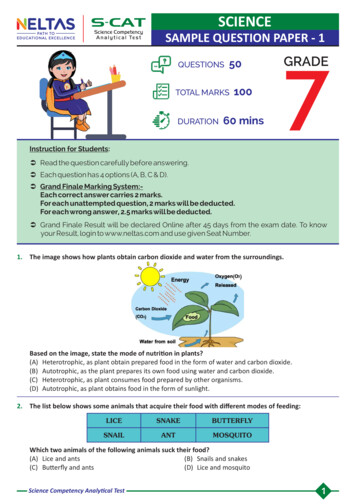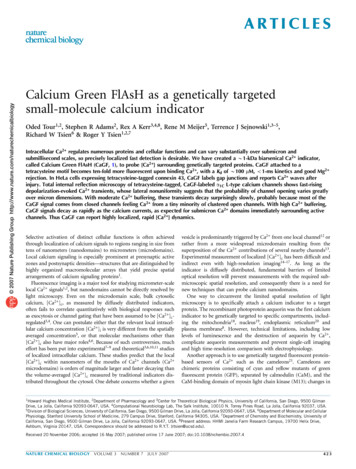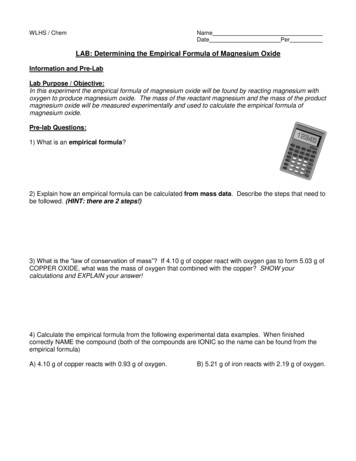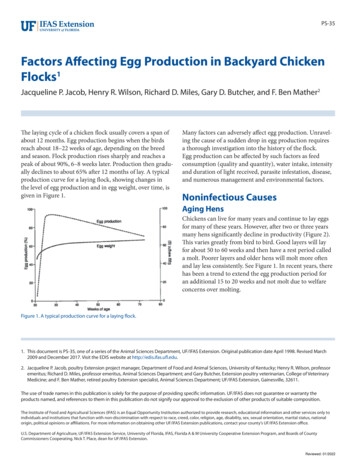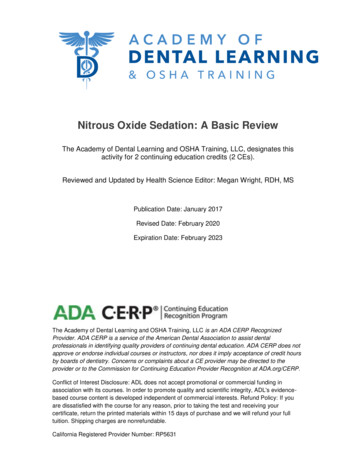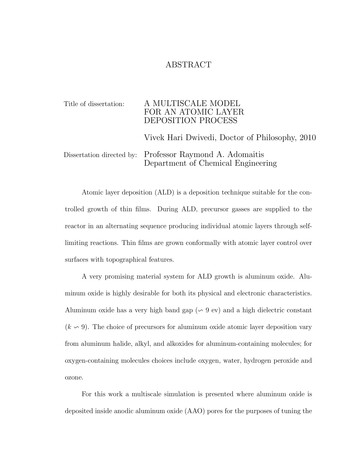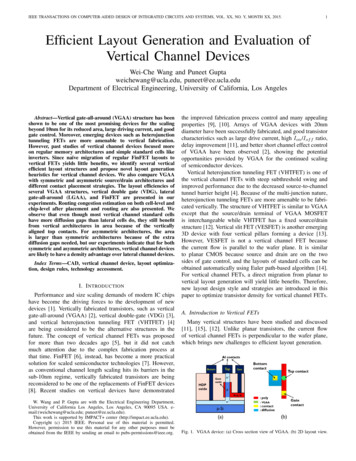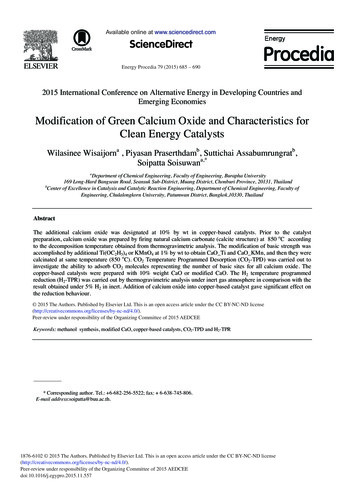
Transcription
Available online at www.sciencedirect.comScienceDirectEnergy Procedia 79 (2015) 685 – 6902015 International Conference on Alternative Energy in Developing Countries andEmerging EconomiesModification of Green Calcium Oxide and Characteristics forClean Energy CatalystsWilasinee Wisaijorna , Piyasan Praserthdamb, Suttichai Assabumrungratb,Soipatta Soisuwana,*aDepartment of Chemical Engineering, Faculty of Engineering, Burapha University169 Long-Hard Bangsean Road, Seansuk Sub-District, Muang District, Chonburi Province, 20131, ThailandbCenter of Excellence in Catalysis and Catalytic Reaction Engineering, Department of Chemical Engineering, Faculty ofEngineering, Chulalongkorn University, Patumwan District, Bangkok,10330, ThailandAbstractThe additional calcium oxide was designated at 10% by wt in copper-based catalysts. Prior to the catalystpreparation, calcium oxide was prepared by firing natural calcium carbonate (calcite structure) at 850 oC accordingto the decomposition temperature obtained from thermogravimetric analysis. The modification of basic strength wasaccomplished by additional Ti(OC2H5)4 or KMnO4 at 1% by wt to obtain CaO Ti and CaO KMn, and then they werecalcinated at same temperature (850 oC). CO2 Temperature Programmed Desorption (CO2-TPD) was carried out toinvestigate the ability to adsorb CO2 molecules representing the number of basic sites for all calcium oxide. Thecopper-based catalysts were prepared with 10% weight CaO or modified CaO. The H2 temperature programmedreduction (H2-TPR) was carried out by thermogravimetric analysis under inert gas atmosphere in comparison with theresult obtained under 5% H2 in inert. Addition of calcium oxide into copper-based catalyst gave significant effect onthe reduction behaviour. 2015 The Authors. Published by Elsevier Ltd. This is an open access article under the CC BY-NC-ND license 2015 The Authors. Published by Elsevier 4.0/).Peer-reviewunderresponsibilitythe OrganizingCommitteeof 2015 AEDCEE.underresponsibilityof theofOrganizingCommitteeof 2015 AEDCEEPeer-reviewKeywords: methanol synthesis, modified CaO, copper-based catalysts, CO2-TPD and H2-TPR* Corresponding author. Tel.: 6-682-256-5522; fax: 6-638-745-806.E-mail address:soipatta@buu.ac.th.1876-6102 2015 The Authors. Published by Elsevier Ltd. This is an open access article under the CC BY-NC-ND nd/4.0/).Peer-review under responsibility of the Organizing Committee of 2015 AEDCEEdoi:10.1016/j.egypro.2015.11.557
686Wilasinee Wisaijorn et al. / Energy Procedia 79 (2015) 685 – 6901. IntroductionCarbon dioxide is the most well known green house gas effecting on global environment moreseriously. The increment of carbon dioxide was mostly from fossil fuel combustion in transportations,electrical power plants and industries which are essentially important for human demand. Although somany energy policies have been launched, the elimination of energy consumption seems ineffective dueto highly increasing population. The utilization of carbon dioxide has been recently emerged asinteresting topics as it is a chemical source of carbon which can turn to beneficial chemicals via catalyticreactions. The carbon dioxide can directly change to methanol and then dimethylether (DME) ordimethylcarbonate (DMC) which is a starting material for chemical industries. The catalytic materialwhich has been widely used to synthesize methanol is CuO-ZnO catalyst. Up to date, effective conditionto produce 98% methanol conversion in industries is operated at high pressure ( atmospheric pressure)and low temperature. Several researches revealed basic surface of the catalyst favoring methanolselection, however methanol synthesis carried out over the catalysts modified by lanthanum [1], fluorine[2], zirconium [3] to obtain different basic species was clearly dependent on basic strength [4]. To insistthese results, calcium oxide was thus chosen as additive to copper based catalysts in our experiment sinceit possesses high basic strength. The carbon dioxide temperature programmed desorption and H 2temperature programmed reduction of copper-based catalyst were carried out to forecast catalytic activityof CO2 hydrogenation or methanol synthesis.2. Experiment2.1. Materials PreparationCalcite calcium carbonate (CaCO3) of oyster shells was employed as starting material to producecalcium oxide and modified calcium oxide. The starting material was mechanically crushed and sieved toequivalent less than 350 mesh size, and then calcination under flowing oxygen 30 ml/min ramping to850 oC for 2 hours. The ramping rate was 5oC/min. Two precursors, i.e. potassium permanganate(KMnO4) or titanium ethoxide (Ti(OC2H5)4), were designated to obtain 1% by weight content of Ti orKMn in the resulting calcium oxide. The KMn precursor was dissolved in distilled water, whereas Tiprecursor was sonicated randomly in ethanol to attain suspension of Ti-based fine particles. The resultingsolution/suspension was slightly impregnated into calcium carbonate and then dried at 100oC andcalcination at 850 oC for 2 hours. The names of these resulting materials are CaO, CaO KMn andCaO Ti, respectively. Additional CaO or modified CaO to copper-based catalyst support (zirconiumdioxide, Tosoh ZrO2) was at 10% by weight in physically mixing support of Tosoh ZrO2 and as-preparedcalcium oxide. The copper-based catalysts were prepared by incipient wetness impregnation at designated10% copper content in the catalysts. The nomenclatures of these catalysts are Cu/ZrO2/CaO,Cu/ZrO2/CaO KMn and Cu/ZrO2/CaO Ti.2.2. Materials CharacterizationThe as-prepared calcium oxide materials were characterized by means of CO2-TemperatureProgrammed Desorption (CO2-TPD). We aim to test the catalysts for CO2 hydrogenation, thus thecopper-based catalysts were characterized by means of H2 Temperature Programmed Reduction (H2TPR) to describe the reduction behavior. The H2-TPR profiles were obtained by ThermogravimetricAnalysis (TGA). 10 mg of the catalysts was placed on alumina crucible in the TGA furnace. Testing 10mg catalyst was carried out under N2 atmosphere and the equivalent testing was carried out under mixture
Wilasinee Wisaijorn et al. / Energy Procedia 79 (2015) 685 – 690of hydrogen in nitrogen (5% H2 in N2) as mentioned elsewhere [5]. The Furnace temperature was rampedto 800 oC with heating rate 10 oC/min. The decomposition rate under both atmospheres was calculated asfollowing. Where wi is initial weight of the catalyst 10 mg and dw/dt is the change of catalyst weight atan interval. The rate of hydrogen consumption tends to apparently correspond to weight decompositionrate while no significant loss of weight under nitrogen atmosphere. The consumption of hydrogen used toreduce the catalysts can be calculated by a net different area of weight decomposition between inertatmosphere and %5 hydrogen in flowing inert gas related to the area corresponding to amount ofhydrogen consumed in reduction of 10-mg copper (II) oxide.3. Results and DiscussionThe carbon dioxide temperature programmed desorption profiles were performed in Figure 1.The amount of carbon dioxide adsorbed on calcium dioxide represents the number of basic sites that canchemically bond to form carbonate species. The amount of carbon dioxide desorption increases whilecompared with our previous results [6]. This is probably due to prolonging the CO 2 saturation for 6 hours.The desorption temperature of carbon dioxide of all as-prepared calcium oxide samples were found at theposition higher than 400 oC, suggesting the high strength of carbon dioxide adsorption sites. The calciumoxide possesses two desorption peaks of carbon dioxide locating at 460 oC and 680 oC, similarly Ti- andKMn-modified calcium oxide exhibits two peak of carbon dioxide desorption. However, modification ofcalcium oxide is likely to diminish the amount of carbon dioxide adsorption sites at high temperature asreported in Table 1, thus modified calcium oxide gives the amount of carbon dioxide adsorptionapparently lower than that of pure calcium oxide. The copper-based catalysts for methanol synthesis viacarbon dioxide hydrogenation were prepared with calcium oxide additives. The zirconium oxide wasemployed as the catalyst support because the high chemical stability can cause good dispersion of activemetal sites. The amount of carbon dioxide adsorption is 3.6 mmol/g, which is the lowest. The strength ofthese base sites located in the low-to-medium region. The adsorption of carbon dioxide was carried outover copper-based catalyst surface in comparison with zirconia support as carbon dioxide desorptionprofiles shown in Figure 2. The all copper-based catalysts are composed of small carbon dioxidedesorption peak under 200 oC. This is possibly owing to intrinsic property of zirconia which possessedtwo carbon dioxide adsorption peaks approximately at 100 and 400 oC, respectively. Third peak ofcarbon dioxide desorption over Cu/ZrO2 located around 600 oC was attributed to the ability to absorbcarbon dioxide of copper-species sites in good agreement of the increase of carbon dioxide desorptionsites of all copper-based catalysts comparing with those of ZrO2, CaO, CaO Ti and CaO KMn asreported in Table 2. Wan Isahak W. N. R. et al revealed the formation of copper carbonate after theadsorption of CO2 heated up until 573 K over Cu2O and CuO [7]. The results clearly emphasize that thecatalysts composed of calcium oxide additive gave carbon dioxide desorption at high temperaturesimilarly to the desorption sites consisting in CaO, CaO Ti and CaO KMn. The significant effect ofcalcium oxide on reduction behaviors exhibits in Figure 3. The decomposition of copper-based catalystscomposed of calcium oxide was found at 400oC under nitrogen atmosphere, possibly suggesting theunstable compound of calcium species, whereas the most stable ZrO2-supported copper catalyst exhibitedunder nitrogen atmosphere solely (gray line in Figure 3). The hydrogen reduction of copper species took aplace approximately at 300 oC for Cu/ZrO2. Another copper oxide species can react at higher temperaturewhile consisting in calcium oxide-modified catalysts. The calcium oxide seems to retard the hydrogenreduction plausibly owing to a formation of copper-calcium oxide compound. The positions of reductiontemperature can determine an effect of metal-support interaction on the formation of less oxidativecopper species (Cu2 o Cu1 o Cu0). The higher reduction temperature gives the higher strength of687
688Wilasinee Wisaijorn et al. / Energy Procedia 79 (2015) 685 – 690metal-support interaction or the formation of metal-support compound. The reducibility of all copperbased catalysts and the reduction temperature are shown in Table 2.Fig. 1. CO2 Temperature Programmed Desorption (CO2-TPD) of as-prepared CaO, CaO Ti and CaO KMnTable 1 Physical property of as-prepared calcium oxide and copper-based catalystsAmount of base sitesDesorption Temperature (oC)(mmol/g)SampleLowMediumHighLowMediumHigh( 300) (300-600) ( 600)( 300) (300-600) ( 600)CaO4607207.66.6CaO Ti4306604.92.8CaO KMn4806809.10.4ZrO21004001.42.2Cu/ZrO2 /ZrO2/CaO Ti804306401.43.75.1Cu/ZrO2/CaO KMn804306401.24.05.2Total amount of basesites (mmol/g)14.27.79.53.66.723.910.210.4Table 2 Reducibility of copper-based catalysts and the amount of base sites after reductionSampleReduction Temperature ( oC)% ReducibilityCu/ZrO2Cu/ZrO2/CaOCu/ZrO2/CaO TiCu/ZrO2/CaO KMnPeak 1305333352Peak 2400400400Peak 3464448453851089889The amount of base sites afterreduction(mmol/g)1.253.240.536.8
Wilasinee Wisaijorn et al. / Energy Procedia 79 (2015) 685 – 690Fig. 2. CO2 Temperature Programmed Desorption of copper-based catalysts and zirconia support (left) and theprofiles of copper-based catalysts after reduction at 400 oC for 6 hours (right)Fig. 3. Hydrogen Temperature Programmed Reduction Profiles of copper-based catalystsThe reducibility was based on the actual amount of hydrogen consumed to reduce the 10-mgcatalyst per the theoretical amount of hydrogen consumed to reduce the 10-mg catalyst. The ability to bereduced of oxide species consisting in calcium oxide modified copper-based catalyst was maximalcompared to others. The reducibility of zirconia supported copper catalyst was only 85% as shown inTable 2 and it was apparently increased while adding the modified calcium oxide to copper-basedcatalysts, however the higher reducibility was possibly ascribed to the reduction of calcium oxide speciesconsuming more hydrogen content. This may not improve the active metal site dispersion. The calciumoxide species was likely to be more chemically stable under KMnO4 and TiO2 modification since we canobserve the reducibility of Cu/ZrO2/CaO Ti and Cu/ZrO2/CaO KMn less than that of Cu/ZrO2/CaO. Thecopper-based catalysts were mostly reduced at temperature lower than 400oC as shown in Figure 3, thus689
690Wilasinee Wisaijorn et al. / Energy Procedia 79 (2015) 685 – 690the temperature at 400oC was chosen to reduce the copper-based catalysts for 6 hour prior to testing CO2hydrogenation. The CO2-temperature programmed desorption was carried out after hydrogen reduction at400oC for 6 hours to measure the number of base sites for all copper-based catalysts as reported in Table2. The reduction at 400oC for 6 hours increased the number of base sites for copper-based catalystsmodified by calcium oxide as reported in Table 2, whereas lower base content belonged to zirconiasupported copper catalyst. These increasing sites deliberated carbon dioxide at high temperature(approximately at 700 oC), suggesting that carbon dioxide chemically bonded to strongly adsorbing sitesafter the reduction.4. ConclusionThe modification of calcium oxide was accomplished by additional Ti and KMn precursors. Themodification differ the amount of base sites and the strength of base sites. The amount of highly strongbases was lower under Ti or KMn modification. The modified calcium oxide was employed as additionaloxide in copper-based catalysts being difference in carbon dioxide absorption. The reduction temperatureand reducibility of copper-based catalysts were significantly different. The reducibility of Cu/ZrO2/CaOwas the highest and it gave higher reduction temperature, possibly suggesting the metal-supportcompound formation or strong interaction of metal and support. The addition of Ti or KMn modifiedcalcium oxide can chemically stabilize the catalysts and lowered the reduction temperature.AcknowledgementsThe authors would like to give their gratitude for financial support from Faculty of Engineering,Burapha University (Grant No. วจพ 6/2557) and Center of Excellence in Catalysis and Catalytic ReactionEngineering, Department of Chemical Engineering, Faculty of Engineering, Chulalongkorn University,Ms. Sutharat Thaongratkeaw.References[1] Guo X., Mao D., Lu G., Wang S., Wu G., The influence of La doping on the catalytic behavior of Cu/ZrO2 for methanolsynthesis from CO2 hydrogenation, J. Mol. Catal. A: Chem., 2011;345: 60-68[2] GaO P., Li F., Zhang L., Zhao N., Xiao F., Wei W., Zhong L., Sun Y., Influence of fluorine on the performance of fluorinemodified Cu/Zn/Al catalysts for CO2 hydrogenation to methanol, J. CO2 Util., 2013 ; 2 : 16-23[3] Arena F., Mezzatesta G., Zafarana G., Trunfio G., Frusteri F., Spadaro L., Effect of oxide carriers on surface functionality andprocess performance of the Cu-ZnO system in the synthesis of methanol via CO2 hydrogenation, J. Catal., 2013 ; 300 : 141 –151[4] Hilmen A.M., Xu M., J.L. Gines M., Iglesia E., Synthesis of higher alcohol on copper catalysts supported on alkali-promotedbasic oxides, Appl. Catal. A : General, 1998 ; 169 : 355-372[5] Kundakovic Lj., Flytzani-Stephanopoulos M., Reduction Characteristics of copper oxide in cerium and zirconium oxide systems,Appl. Catal. A : General, 1998 ; 171 :13-29[6] Soisuwan S., Phommachant J., Wisaijorn W., Praserthdam P., The characteristics of green calcium oxide derived from aquaticmaterials, Procedia Chem., 2014; 9:53-61[7] Wan Isahak W.N.R., Che Ramli Z.A., Wafiuddin Ismail M., Ismail K., M. Yusop R., Wahab Mohamed Hisham M., AmbarYarmo M., Adsorption-desorption of CO2 on different type of copper oxides surface: Physical and Chemical attractions studies,J. CO2 Util., 2012; 2: 8-15
to the decomposition temperature obtained from thermogravimetric analysis. The modification of basic strength was accomplished by additional Ti(OC 2H 5) 4 or KMnO 4 at 1% by wt to obtain CaO_Ti and CaO_KMn, and then they were calcinated at same temperature (850 oC). CO 2 Temperature Programmed Desorption (CO 2-TPD) was carried out to

